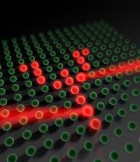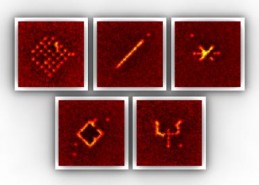Quantum pen for single atoms is step toward large-scale quantum computing
March 18, 2011

Controlling single atoms in a lattice of light. They succeeded in having total control over the single atoms and in "writing" arbitrary two-dimensional patterns. (Image: Max Planck Institute)
Physicists at the Max Planck Institute of Quantum Optics have succeeded in manipulating atoms individually in a lattice of light and arranging them in arbitrary patterns, says the team of Stefan Kuhr and Immanuel Bloch — an important step towards large-scale quantum computing, they suggest.
A register of hundreds of addressable quantum particles could serve for storing and processing of quantum information in a quantum computer.
The scientists loaded laser-cooled rubidium atoms into an artificial crystal of light. These optical lattices were generated by superimposing several laser beams. Starting from an arrangement of 16 atoms that were strung together on neighboring lattice sites, the scientists studied what happens when the height of the lattice is ramped down so far that the particles are allowed to “tunnel” according to the rules of quantum mechanics.

The optical-lattice addressing scheme allows for creating arbitrary patterns of atoms, each consisting of 10 to 30 single atoms in an artificial crystal of light (Image: Max Planck Institute)
They showed that each site of the optical lattice can be filled with exactly one atom. With the help of a microscope, the scientists could visualize the shell-like structure of this “Mott insulator” atom-by-atom. They could address and change the spin of single atoms with laser light down to a diameter of 600 nanometers and “write” them in arbitrary two-dimensional patterns.
“A Mott insulator with exactly one atom per lattice site acts as a natural quantum register with a few hundred quantum bits, the ideal starting point for scalable quantum information processing,” explains Kuhr.
Kuhr suggests that a further step is to realize elementary logical operations between two selected atoms in the lattice to create quantum gates.
Their work appears in the journal Nature.